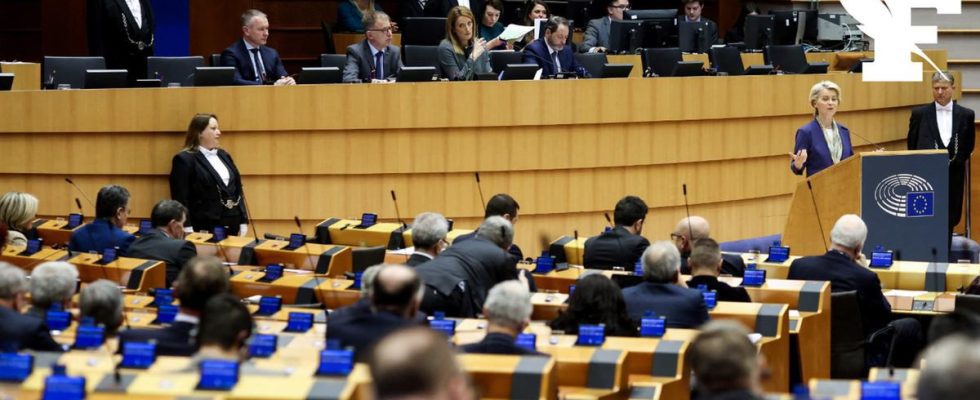After tackling the end of thermal engines at the start of the week, the 27 continue their series of announcements from the climate plan.
EU Member States and MEPs agreed on Thursday to almost double the share of renewables in the European energy mix by 2030, while taking into account the role of nuclear in producing carbon-free hydrogen, a subject that has been strongly divided the Twenty-Seven.
The text, approved at dawn after fifteen hours of final talks, sets a binding target of 42.5% of renewables in European consumption by the end of the decade, i.e. a virtual doubling of the level currently around 22% (just over 19% in France). This target is halfway between the 45% demanded by the European Commission and MEPs, and the 40% demanded by the States. It marks a very clear increase compared to the current EU target for 2030 (32%).
To achieve this, the approved text provides for the facilitation and acceleration of authorization procedures for renewable energy infrastructures, with the establishment of dedicated territories where regulations would be relaxed. The agreement also makes biomass (wood burned to produce electricity) a source100% green», underlined MEP Markus Pieper (EPP, right), rapporteur of the text.
Read alsoBertille Bayart: “On nuclear power, the endless fight between France and Germany”
A nuclear recognized as “neither green nor fossil”
This “bioenergy”, defended in particular by the Scandinavian countries, is however strongly denounced by environmental NGOs, worried about the impact on forests as carbon sinks and refuges of biodiversity. However, the use of primary forest biomass has been more strictly defined and supervised. “The use of biomass is better regulated even if Parliament wanted to go further“, notes the MEP Pascal Canfin (Renew, liberals), president of the parliamentary committee Environment.
Finally, the text assuresrecognition of the specific role of nuclear power, which is neither green nor fossil», adds Pascal Canfin. This point has been the subject of sharp differences in recent weeks between the Twenty-Seven, reviving the divisions between defenders and detractors of the civilian atom. While the text provides for ambitious hydrogen targets “renewable“to be achieved in transport and industry, France and its allies demanded equal treatment between renewable hydrogen and hydrogen”low-carbon» produced with electricity of nuclear origin.
Read alsoEU ‘bank’ to support green hydrogen operational this year
Different objectives depending on the country
A red line for several countries (Germany, Austria, Denmark, Ireland, Luxembourg, Portugal, Spain…), which refused to encourage, in a text devoted to green energies, the production of hydrogen from nuclear power, at the risk slow down investments in renewables. Eventually, the Swedish EU presidency, which was leading the discussions on behalf of member states with MEPs, proposed a compromise aimed at relaxing the targets for countries with significant carbon-free electricity production.
According to the agreement reached, the renewable hydrogen target for 2030 can be reduced by 20% for Member States where the share of fossil hydrogen in the country’s hydrogen consumption is less than 23%. “This means that France will not be obliged to build renewables to make hydrogen for industry and transport but will also be able to use nuclear power (to meet the European objective). It was an absolute condition for France to support the final agreement», underlined Pascal Canfin.
“data-script=”https://static.lefigaro.fr/widget-video/short-ttl/video/index.js” >
